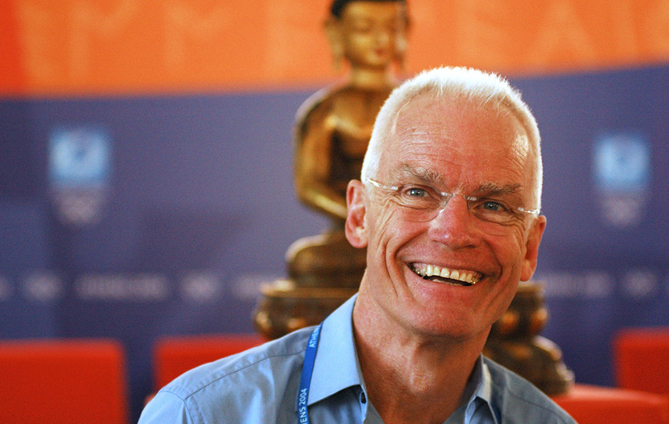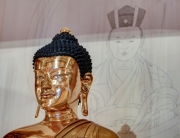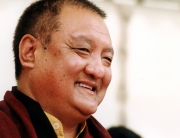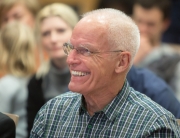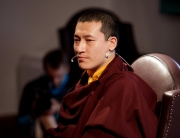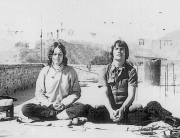In Tibet, there were three possible ways of following Buddhism: one might become a monk, practice as a lay person, or be a yogi. Monks and nuns lived separately in monasteries and nunneries and had strict rules of conduct. The lay people had families, a normal occupation and tried to put the teachings into their everyday lives. The yogis lived unrestricted by social norms, often in various caves with changing partners and focused their entire lives on spiritual development (one example is the well known yogi, Milarepa).
Since today people in developed countries have the means to decide the number of their offspring, there will be no large Buddhist monasteries. The reason for men and women to live separately in earlier times was not that Buddha was prudish, or that his teachings were hostile to the body. Nor did he have a fear of future heirs to contest accumulated wealth like the Catholic church. People simply could not make love without having children and family, which restricted their time for study and meditation. The vows of monks and nuns were gathered from Buddha’s advice to various followers and groups, and though much looks strange in a modern setting, they cannot be changed to fit new situations.
In the West, however, the originally separate groups of yogis and lay people are coming very close. As there is no need for the former to compete with the red-robed monks and nuns in obtaining the support of the productive population, they also don’t need the outer props which formerly made them easily distinguishable, like flowing white robes and wild hair styles. This reduces the distance from the lay people of today, who on their side are so freely backed by a welfare state that they no longer need to establish vast families for looking after them in old age. My students around the world seem to bridge and unite the best of both ways. In their daily lives they generally hold the Mahamudra, a yogi’s liberating view, while accomplishing whatever is expected for a productive and meaningful life. Only during holidays does the traditional yogi style manifest outwardly, as many move their tents from one meditation course to the next.
2550 years ago in India, many people seem to have been attracted to Buddha’s advice about cause and effect. Less, apparently, wished to hear about wisdom and compassion, and only a few had the conditions for the pure view of the Diamond Way. Today in the West, with plenty of gifted people and good karma around, many wish to experience the space-clarity of mind while they prefer to leave questions of cause and effect relative (and with the police: whether they manage to catch one or not. Also, philosophy and psychology only have minor pull, since most have been fed these subjects in uninspired ways in school. Modern, self-confident people want experience.
The Western Framework of the Teachings
Whoever supports Buddha’s teachings is a link in an unbroken chain. Whether this happens through giving money for Buddhist centers to run, through being a local or a traveling teacher, or an example to society, family and friends, one should know as much Buddhism as possible. Even those who prefer working with beings on a case by case basis will see their effectiveness grow vastly when they obtain a view of the whole path and can choose among its wide range of methods. With sufficient insight, one can stabilize peoples’ development and convey a joyful anticipation of the levels ahead. For such practical aims, however, the institutional separation of the teachings into Vinaya, Sutra, Abhidharma and Vajrayana is too remote. Here, one needs a practice-oriented approach to their richness. Before embarking on that, however, a few words to all hopefuls who plan a massive assault on the frustrations of conditioned existence: one needs a long breath.
Even though the world offers increasing numbers of glossy ways to attain spiritual experiences, reality is far from that. The karmic habitual energies of beings are of a sticky quality, and few have the necessary basis for even starting on a path – which is the certainty that they possess a mind and can work with it to obtain lasting results. Today this means understanding that mind is not produced by the impermanent brain but transformed by it; that its stream of information moves since beginningless time from one conditioned existence to the next, picking up the experiences which mature as one’s next life… that this goes on until one recognizes the mirror behind the pictures, mind’s unconditioned state. The veils covering one’s consciousness exist since beginningless time and are no weak opponent. Even with the strongest of blessing and meditations, their removal must happen step by step.
As already mentioned, the finest and only lasting richness one may bring beings is an insight into their unconditioned nature. But how to do that?
Among today’s confusing variety of teachers, one may actually recognize a good Lama or Buddhist author by the fact that he points to transforming methods. He does not try to please his students by talking sweetly around difficult subjects, leaving them with the superficial satisfactions of having their exotic or preconceived ideas confirmed but with little or no real guidance. Even Lamas of the three “old” Tibetan lineages who have the power to zap their students with the Mahamudra or Dzog Chen, the Buddha’s ultimate teaching, should quickly recommend the practical way to that state: the not-so-glorious foundational practices such as the seemingly endless repetitions called the Ngondro. These practices help produce the subconscious richness and purifications which are the only lasting basis for joy.
“Higher practices” are thus “self-secret” and only become relevant when their foundation has been accomplished in this or an earlier life. Also, as a body in itself represents a lot of inertia, each subsequent physical form must have its channels of wisdom opened up, a painstaking process. The beginning of being’s spiritual search is a quest for happiness, and the discovery that it is produced by useful thoughts, words and actions. Thus, one starts to work practically with cause and effect. The improved feedback both from the external world and from one’s own store-consciousness gradually liberates mind’s wealth, and manifesting as compassion and inspired wisdom, such motivation will guide body and speech to further benefit others. From a foundation of so much good, a strong attraction towards mind’s full potential will arise as well as devotion towards those having realized it. These feelings constitute a very fast lane to enlightenment. Each of the three levels mentioned fits a type of human being: the egocentric, the altruistic, and the yogi, and all need three supports for their unfoldment: the pillars of “knowledge with questions,” “meditation,” and “holding the level.”
BUDDHISM TODAY, Vol.1, 1996. Copyright ©1996 Kamtsang Choling USA.


